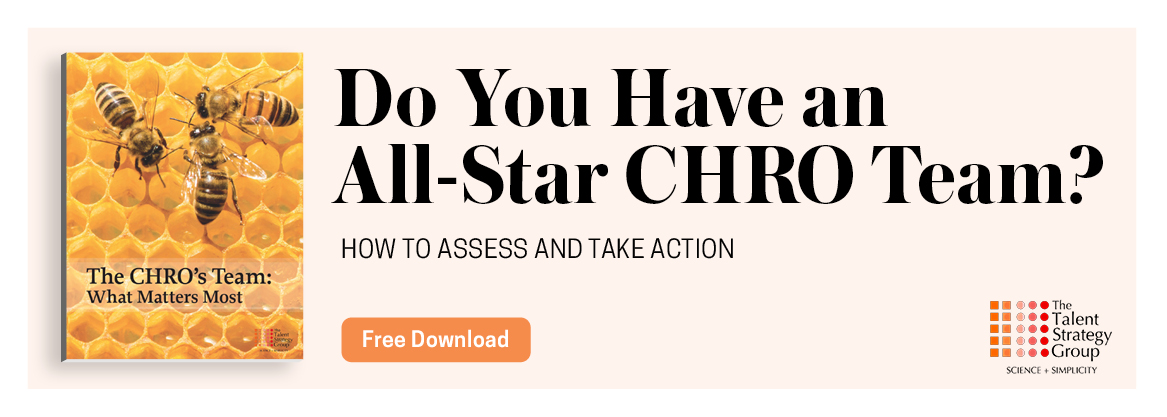You don’t need a Fortune 500–size wallet to hire and retain top talent. Here’s your roadmap to success, no matter your size.
By Larry Inks, Ph.D., and Raymond Noe, Ph.D.
Time and again, research by the National Center for the Middle Market has demonstrated the link between exceptional talent and strong company performance. It’s no surprise that having the right people in the right positions is essential to helping an organization achieve its goals.
Yet, quarter after quarter, the center’s Middle Market Indicator reveals that talent issues keep the executives at middle market organizations—companies that generate between $10 million and $1 billion in annual revenue, of which there are nearly 200,000 in the U.S.—up at night.
Sign up for the monthly TalentQ Newsletter, an essential roundup of news and insights that will help you make critical talent decisions.
One way in which an organization can address its talent challenges—and ensure it can count the best and brightest among its ranks—is to strategically and successfully plan for its current and future talent needs. That encompasses identifying key positions and players, understanding skills gaps, and creating succession plans to keep crucial roles filled today and in the future. Talent planning should motivate all of a company’s HR endeavors, including staffing, performance management, and development.
While the middle market represents only 3 percent of all U.S. companies, it accounts for a third of U.S. private-sector GDP and jobs. The middle market is the segment that drives U.S. growth and competitiveness, which is why it’s so important for these organizations to nail crucial talent decisions. And that’s where this survey comes in.
The National Center for the Middle Market, in partnership with Vistage, surveyed 400 c-level middle market executives who are actively engaged in attracting and retaining talent for their organizations. The survey was designed to identify the importance and prevalence of various talent planning activities among middle market firms, which includes some of the fastest-growing and best-performing companies in the U.S. The survey also assesses overall talent planning performance and identifies challenge areas for middle market companies. Here are the results.
6 Takeaways for Middle Market Firms
Takeway #1: Talent planning is a powerful business driver.
The best-performing middle market businesses place more importance on talent planning than their slower-growing peers. They’re also more likely to engage in a full suite of talent activities like succession planning, talent review, human resources planning, and bench strength analysis.
Specific actions that organizations often undertake as part of this broad initiative include identifying their high-potential employees, annually rating employees on potential for future movement, identifying critical positions and bench strength for those positions, and determining skills gaps.
Companies that enjoy annual revenue growth of 10 percent or more are significantly more likely to say they perform very or extremely well at identifying critical positions and can’t-lose players within the organization and engaging senior and line management in the talent planning process.
And the results and learning that an organization gleans from productive talent planning have implications for other human capital management processes, such as talent acquisition (recruiting and staffing), performance management, and talent development.
As an example, the ability to not only develop but to know who within the organization can step up to larger roles can minimize an organization’s need to look externally for talent.
Takeaway #2: Size and structure has a significant impact on how talent planning is conducted.
As firms grow, they tend to put greater emphasis on talent planning and adopt more formalized processes. The ultimate responsibility for talent planning rests with the human resources director in about half of middle market companies. However, executive management also plays a role. In three out of 10 midsize companies, c-level execs take the reins of the talent planning process. Regardless of who is ultimately in charge, the brass typically weighs in.
Across middle market businesses, the president, vice president, business unit leaders, and c-level executives are highly likely to be at least somewhat involved in talent planning decisions, both company-wide and within individual business units.
While a slight majority of middle market firms employ somewhat formalized talent planning processes, about a quarter do little, if any, documenting. Companies that keep talent planning the most informal tend to be the smallest middle market businesses. Family-owned companies are more likely to be ad hoc, while private equity firms typically adopt a more formalized approach.
Takeaway #3: The biggest thing companies lack is a systematic framework.
There’s a clear correlation between process formalization and how well companies perform at talent planning, and a well-defined link between the number of activities implemented and overall talent planning performance: Just 22 percent of all middle market firms have a formalized talent planning process in place. Among companies that consider themselves the best at talent planning, 39 percent rely on a formalized process.
The fast-growing, high-performing middle market firms are also much more likely to have a defined process and to perform multiple talent planning activities in a coordinated way.
Takeaway #4: There’s a lot of room for improvement.
The vast majority (90 percent) of middle market firms do engage in at least one talent planning activity. But just 14 percent of firms give themselves an “A” grade when it comes to overall talent planning effectiveness, while more than four in 10 companies grade themselves a “C” or lower.
The center’s research shows that the more activities a firm implements, the better it grades its overall talent planning effort. Specifically, 80 percent of middle market businesses engaging in seven or more talent planning activities grade themselves an “A” or a “B.” Among firms that engage in two or fewer talent planning activities, just 38 percent give their efforts top marks.
Overall, the prevalence of some of the most important talent planning processes is not as high as one might expect. In fact, key activities are currently in place at fewer than half of middle market businesses. The most common weaknesses include succession planning, identifying skills gaps, and having processes in place for identifying and developing high-potential employees.
Takeaway #5: Successful talent planning involves four core elements. An effective talent planning framework is carefully considered and comprehensive, with activities divided into four main categories:
- Aligning talent and corporate strategies.
- Building sufficient processes to ensure systematic talent planning efforts.
- Involving leadership in the process as opposed to handing off to human resources.
- Engaging employees in talent planning and ensuring they recognize the value of the process.
Takeaway #6: Succession planning, programs for high-potential employees, and identification of skills gaps are areas for improvement. While middle market companies view these activities as important to talent planning success, performance is lacking. Focusing on improving these critical aspects of a firm’s talent planning strategy is likely to have the greatest overall impact on talent planning success.

Align, Build, Lead & Engage (ABLE): A Framework for Talent Planning
When middle market firms have a formal process in place for talent planning, and when they adopt a comprehensive and diverse approach, they do better overall. That’s why the center has created the ABLE framework, which can assist middle market companies in implementing and coordinating more talent planning activities and bring more structure and robustness to the process.
By adhering to the framework, companies can also be sure that they are putting adequate focus on areas that are viewed as critical to talent planning, but where current performance may be lacking. And by creating more formal processes for these specific areas—namely succession planning, identification of high-potential employees, and identification of skills gaps—companies are likely to realize the greatest improvements in their talent-planning efforts.
Align Talent Planning with Strategy
- Understand the human capital implications of your strategic and tactical objectives.
- Ensure that talent strategy and corporate strategy are aligned.
- Include talent planning in all strategy discussions (annual plan, M&A).
- Discuss important talent planning actions (promotions, manage outs) at quarterly meetings.
- Identify critical positions.
- Identify current and future skills gaps.
Build Processes to Enable Successful Talent Planning
- Create succession plans for essential roles and individuals.
- Develop robust processes for performance reviews.
- Assess bench strength for critical and identified positions.
- Develop large talent pools (both internally and externally) for critical and identified positions.
- Map career paths and retirement dates.
- Identify manage outs, potential transfers, and other likely open positions.
- Analyze turnover rates to understand patterns and vulnerabilities.
- Conduct development discussions between managers and direct reports.
- Conduct talent review and group level discussions of talent (to drive consensus and accountability).
Lead by Example
- Walk the walk—ensure that executive and line management actively engage in talent planning and performance reviews (don’t delegate to HR).
- Identify critical individuals and develop succession plans for each of those key individuals.
- Help senior leaders get to know high-potentials and other critical talent.
- Hold people at all levels accountable for their performance.
- Align incentives and bonuses to strategy.
- Support and ensure open, candid discussion in talent review meetings.
Engage the Organization
- Implement a process to identify top performers.
- Ensure that top performers are rewarded appropriately.
- Clearly define “high-potential” and create a process to identify it.
- Ensure the organization understands the difference between performance and potential.
- Ensure the organization understands the difference between high-potentials and annual ratings of potential.
- Develop programs to help high-potentials achieve their potential.
- Develop a mentoring program for (at least) high-potential talent.
The Future State of Talent
With the quality of a company’s talent so closely aligned with its success, talent planning is a critical strategy for middle market businesses. By adopting some of the best talent practices of high-performing middle market organizations, companies can better position themselves for improved overall performance.
Larry Inks, Ph.D., is a clinical associate professor of management and human resources at the Fisher College of Business at The Ohio State University. He teaches both undergraduate and graduate level classes in the areas of talent management, organizational behavior, human resource management, staffing, and research methods.
Raymond Noe, Ph.D., is a professor of management and human resources and the MHRM Program Director at the Fisher College of Business at The Ohio State University. He is an author of three texts in human resource management, including Employee Training and Development.


